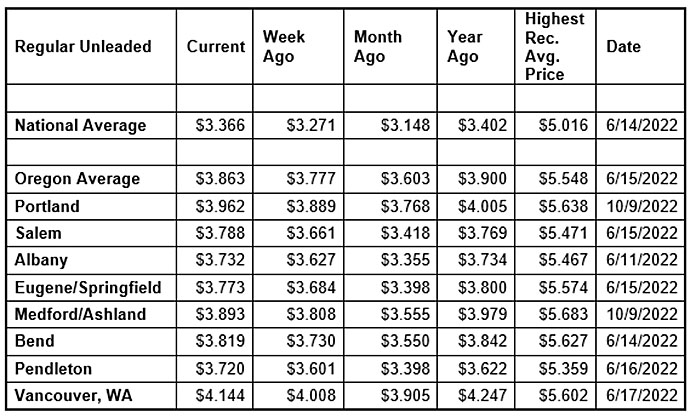Pump prices are rising across the country due to refinery maintenance and the switch to summer-blend fuel. Here in the Pacific Northwest, the increases are amplified by the closure of locks on the Columbia River, which has prevented fuel barges from moving through.
This has created tight supplies in the Pacific Northwest and soaring gas prices. For the week, the national average for regular jumps 10 cents to $3.37 a gallon. The Oregon average climbs nine cents to $3.86 a gallon. This is the 20th-largest week-over-week gain for a state in the nation.
Maintenance on the locks along the Columbia River in the Pacific Northwest has been one of the reasons for tighter gasoline supplies in the area. Wholesale prices shot up and those increase are being passed on to consumers in higher retail prices. Work is expected to wrap up by the end of March. In addition to the lock closures, refinery maintenance, both planned and unplanned, is underway in the San Francisco Bay area. This is also putting a crimp in supplies and contributing to higher prices on the West Coast.
This is the time of year for the seasonal climb in gas prices due to refinery maintenance and the switch to EPA-mandated summer-blend fuel. California switches earlier than other states, and as a result, supplies have tightened in the West Coast region.
“Things have settled down a little since last week, when the Oregon average for regular had the biggest weekly jump in the nation. But drivers can expect rising prices for the next several weeks due to the temporary decrease in supplies,” says Marie Dodds, public affairs director for AAA Oregon/Idaho. “Demand for gas also rises in March and April due to spring break and milder weather. Growing demand amid tighter supplies put upward pressure on pump prices.”
All counties in Oregon except Curry ($4.17), Harney ($4.02), and Multnomah ($4.04) and have averages below $4 a gallon. The Oregon average began 2024 at $3.79 a gallon compared to $3.86 today. The national average started the year at $3.11 and is at $3.37 today.
Oregon is one of 47 states and the District of Columbia with higher prices now than a week ago. Ohio (+26 cents) has the largest week-over-week gain in the nation. Last week, Oregon had the largest weekly jump for a state in the nation. This week, Oregon has the 20th-largest increase. New Jersey (-1/2 cent) has the biggest weekly decline.
After eight weeks, California ($4.85) bumps Hawaii ($4.71) as the state with the most expensive gas in the nation. Washington ($4.14) is third and Nevada ($4.07) is fourth. These are the only four states with averages at or above $4, up from three states a week ago. This week 40 states and the District of Columbia have averages in the $3-range. Six states have averages in the $2 range this week.
The cheapest gas in the nation is in Mississippi ($2.91) and Texas ($2.94). No state has had an average below $2 a gallon since January 7, 2021, when Mississippi and Texas were below that threshold.
The difference between the most expensive and least expensive states is $1.94 this week, compared to $1.86 a week ago.
All 50 states and the District of Columbia have higher prices now than a month ago. The national average is 22 cents more and the Oregon average is 26 cents more than a month ago. This is the 20th largest monthly gain in the nation. Illinois (+56 cents) has the largest monthly increase.
Oregon is one of 35 states with lower prices now than a year ago. The national average is four cents less and the Oregon average is four cents less than a year ago. Colorado (-$1.00) has the largest yearly decrease. Illinois (+20 cents) has the largest year-over-year increase.









